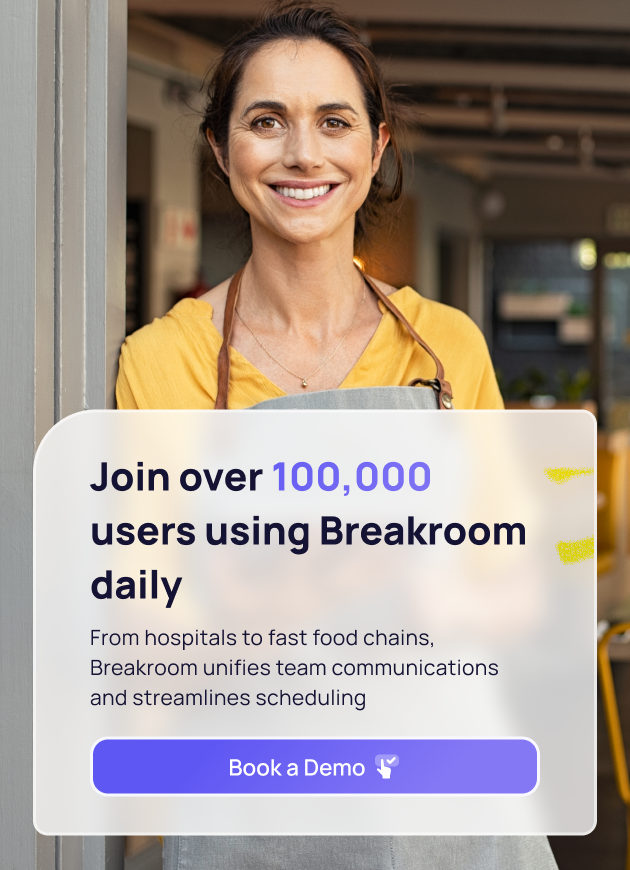Sarah, the general manager of a busy Taco Bell location, noticed something odd in her team's communication patterns. Jessica, normally quick to respond to shift updates and active in group discussions, had been radio silent for three days. Traditional performance management would catch this decline weeks later during a scheduled review. By then, Jessica might have already quit or her performance could have affected the entire team.
But Sarah caught it early through communication data. A quick check-in revealed Jessica was struggling with her class schedule and considering leaving. Within 24 hours, they worked out a solution that kept a valuable team member while preventing the performance spiral that typically follows employee disengagement.
This is the power of communication-based performance management built specifically for hourly workers.
Traditional Performance Management Fails Frontline Workers
Most performance management systems were designed for desk workers with predictable schedules, regular one-on-ones, and stable team structures. When applied to hourly employees, these systems create more problems than they solve.
Consider the reality of frontline work: Teams change daily based on shift assignments. Managers oversee 15-30 employees across multiple shifts, making regular face-to-face coaching nearly impossible. Performance issues develop and spread quickly in team environments where collaboration directly impacts customer experience and operational efficiency.
Traditional quarterly reviews capture performance problems long after they've damaged team dynamics, customer satisfaction, and revenue. Annual goal-setting makes little sense for roles where priorities shift daily based on customer volume, staffing levels, and operational demands.
The solution lies in recognizing that communication patterns provide real-time insight into employee engagement, job satisfaction, and performance trajectory. For hourly workers who interact constantly throughout their shifts, communication frequency becomes the earliest and most reliable performance indicator available to managers.
Communication Frequency: The Hidden Performance Metric
Research across industries shows that engaged, high-performing hourly employees maintain consistent communication patterns that predict their success weeks before traditional metrics catch performance changes.
High performers typically:
- Respond to announcements within 2-4 hours
- Ask clarifying questions when procedures change
- Share knowledge with newer team members
- Communicate proactively about potential issues
- Participate in shift planning discussions
When these patterns change, performance problems follow predictably. An employee who stops asking questions often feels disengaged. Team members who delay responding to updates frequently miss important operational changes. Workers who become communication-silent typically struggle with job satisfaction or external stressors affecting their work.
The key insight: Communication patterns change 2-4 weeks before performance metrics show decline. This creates a massive opportunity for early intervention that prevents performance problems rather than reacting to them.
The Shift-First Performance Model
Rather than adapting desk-worker performance management for hourly employees, effective frontline performance management should start from the unique realities of shift work.
Peer Performance Networks
Hourly workers succeed through peer collaboration more than individual achievement. Unlike desk workers who often work independently, frontline employees depend on teammates for shift coverage, knowledge sharing, and operational support.
The Shift-First model recognizes that individual performance is inseparable from team communication health. Managers can identify high-potential employees by tracking who shares knowledge, helps with problem-solving, and maintains positive team communication even during stressful shifts.
Real-Time Performance Adjustment
Desk workers can often recover from a slow morning or unproductive afternoon. Frontline workers operating during peak customer hours don't have this luxury. Performance issues during a lunch rush or holiday shopping period immediately impact revenue and customer experience.
Communication platforms enable managers to provide real-time performance coaching through quick messages: "Great job handling that difficult customer," "Remember to suggest the promotional item," or "Need backup at register 3." These micro-coaching moments, impossible with traditional performance systems, allow immediate performance improvement when it matters most.
Shift Continuity Performance
One of the biggest performance challenges for hourly workers is knowledge transfer between shifts. When the morning team learns about a new procedure, broken equipment, or difficult customer situation, that information must reach the afternoon and evening teams to maintain performance standards.
Communication platforms create performance continuity that traditional systems miss entirely. Teams that maintain strong communication between shifts consistently outperform those relying on verbal handoffs or written notes that may be missed or misunderstood.
Recognition-Driven Improvement
Hourly workers often receive feedback only when something goes wrong. This reactive approach creates performance anxiety rather than improvement motivation. Communication platforms enable managers to provide immediate positive reinforcement when they observe good performance.
A quick message acknowledging excellent customer service, efficient problem-solving, or helping a teammate creates performance motivation that lasts much longer than formal recognition delivered weeks later during a review.
Non-Invasive Performance Management Through Messaging
The beauty of communication-based performance management lies in its natural integration with daily work. Rather than disrupting schedules for formal performance discussions, managers can support employee development through the communication that already happens during shifts.
Observation Without Oversight
Traditional performance management often feels like surveillance to hourly workers. Managers conducting formal observations can change team dynamics and create artificial behavior that doesn't reflect normal performance.
Communication platforms provide performance insights through natural interactions. Managers can see who takes initiative in problem-solving discussions, which team members mentor newer employees, and how different people respond to operational challenges. This organic performance data is more accurate than formal evaluation sessions.
Flexible Coaching Delivery
Hourly workers have unpredictable schedules that make traditional coaching sessions difficult to arrange. A team member working closing shifts may not be available for morning meetings. Split schedules and varying hours make consistent coaching nearly impossible with traditional approaches.
Messaging platforms allow managers to deliver coaching when employees are available and receptive. A quick performance tip sent during a break is more effective than a formal session scheduled during an employee's off hours.
Scalable Individual Attention
Managers overseeing large hourly teams struggle to provide individual performance attention with traditional methods. Fifteen-minute monthly one-on-ones for 25 employees require more than six hours of dedicated meeting time, often impossible with operational demands.
Communication platforms make individual attention scalable. Managers can send personalized performance feedback, answer individual questions, and provide specific coaching to multiple team members simultaneously. A message recognizing an employee's improvement or suggesting a development opportunity takes seconds but has lasting performance impact.
Implementing Communication-Based Performance Management
Successful implementation requires rethinking performance management around communication workflows rather than forcing communication into existing performance structures.
Start with Communication Health Metrics
Before focusing on traditional performance indicators, establish baseline communication patterns for your team. Track response times to announcements, participation in group discussions, and frequency of proactive communication about work issues.
Teams with healthy communication patterns consistently show better performance across traditional metrics. Poor communication health predicts performance problems before they affect customer service or operational efficiency.
Create Performance Communication Rhythms
Rather than scheduling formal performance check-ins, build performance conversations into natural communication rhythms. Start shifts with brief team messages highlighting priorities. End shifts with recognition for good performance observed during the day.
Weekly team announcements can include performance tips, process improvements, and recognition for employees who demonstrated excellent work. This ongoing performance dialogue is more effective than quarterly formal reviews.
Use Data to Guide Conversations
Communication platforms provide rich data about team interaction patterns, response rates, and engagement levels. Use this information to identify employees who might benefit from additional support, recognition, or development opportunities.
An employee whose communication patterns show decreased engagement might need help with scheduling challenges, training on new procedures, or recognition for contributions that others haven't noticed.
Measuring Communication-Performance Connection
The effectiveness of communication-based performance management becomes clear through metrics that traditional systems miss:
- Early Problem Detection: Time between performance issue emergence and management intervention
- Team Knowledge Transfer: Speed and accuracy of information sharing between shifts
- Employee Development: Growth in communication engagement and leadership behaviors
- Performance Recovery: Time from performance coaching to measurable improvement
Organizations implementing communication-first performance management typically see 40% faster performance problem resolution and 25% improvement in team performance consistency across shifts.
The Future of Hourly Performance Management
Communication patterns provide the earliest, most accurate predictor of employee performance available to managers. For hourly workers whose success depends on team collaboration, operational awareness, and customer interaction, communication frequency offers insights that traditional performance metrics capture too late to be useful.
The most successful frontline managers are already recognizing that performance happens in real-time, between people, through communication. Formal performance management systems should support and measure these natural performance dynamics rather than replacing them with artificial processes designed for different types of work.
When managers can predict performance challenges 30 days in advance through communication patterns, they can prevent problems instead of reacting to them. This shift from reactive performance management to predictive performance support represents the future of hourly employee development.
The question for managers overseeing frontline teams is simple: Are you measuring performance after problems develop, or are you reading the early warning signs that communication patterns provide every day?








